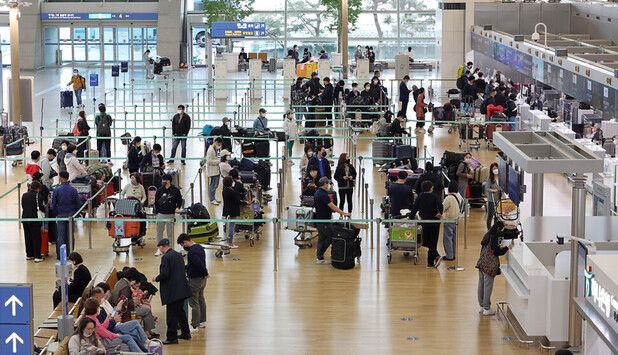hankyoreh
Links to other country sites 다른 나라 사이트 링크
S. Korea reports 5 more cases of BA.2.12.1 COVID-19 subvariant in travelers from US

South Korea reported an additional five cases of BA.2.12.1, a subvariant of the COVID-19 Omicron variant, bringing the total number of cases in the country to six.
South Korean disease control authorities are calling the new mutation “the most concerning variant” of COVID-19 given its rapid spread in other countries. Despite fears, “there is no particular difference in severity, so it is not considered a risk factor such as [in terms of] an increase in mortality,” the authorities said.
The Central Disease Control Headquarters (CDCH) said in a briefing Tuesday that five additional cases of the BA.2.12.12.1 variant were detected domestically and that epidemiological investigations were currently underway. All of the cumulative six cases reportedly came from the US.
The first person infected with BA.2.12.1 in Korea arrived from the US on April 16 and was confirmed to have COVID-19 the following day on April 17. This individual had completed three rounds of vaccination and showed symptoms such as a sore throat and runny nose. Since then, five people who arrived from the US, including one each on April 18, 22, and 24, and two on 28, were confirmed to be infected with the new mutation the following day.
The two individuals who arrived on April 18 and 24 were asymptomatic while the remaining three showed symptoms such as a sore throat. While the individual who arrived on April 18 had completed two rounds of COVID-19 vaccination, all the others had gotten three jabs.
The BA.2.12.1 subvariant, first detected in the US in December 2021, is known to spread 23%-27% faster than the BA.2 “stealth Omicron” subvariant. The new subvariant has accounted for a swiftly increasing share of US COVID-19 cases, jumping from 6.9% on April 2 to 28.7% on April 23.
In particular, the share of cases of the BA.2.12.1 variant in proportion to total COVID-19 cases in and around downtown New York is 90%.
Health authorities said they are also watching the BA.4 and BA.5 subvariants that are prevalent in South Africa. Lee Sang-won, director of the CDCH epidemiological investigation and analysis team, said that health authorities are on alert regarding the BA.4 and BA.5 variants but that “the risk is judged to be low because the area where it has spread is limited.” So far, these two mutations have not yet been detected within South Korea.
A total of six cases of Omicron recombinants have been confirmed locally so far (one case of XQ, three of XE, and two of XM 2). Park Yeong-jun, leader of the epidemiological investigation team at the CDCH, said that two of the recombinant cases were in people living together while eight were among colleagues. “It was not confirmed whether there were any more mutations,” Park added.
Meanwhile, the health authorities attributed the recent slowdown in the decline in COVID-19 cases to the increase in public activity. On Monday, new confirmed cases hit 20,601, an increase of 525 from the 20,076 cases a week prior. The number of confirmed cases for a Monday, which had decreased for seven consecutive weeks, showed an uptick for the first time in eight weeks.
“Activity indicators such as on Google are the highest since January of this year,” says Lee Sang-won, adding that the increased activity is likely related to the recent holidays.
“The possibility that the decline [of the decrease in COVID-19 cases] will stagnate in the future or shift to a slight increase cannot be ruled out,” Lee said.
By Jang Hyeon-eun, staff reporter
Please direct questions or comments to [english@hani.co.kr]

Editorial・opinion
![[Column] Welcome to the president’s pity party [Column] Welcome to the president’s pity party](https://flexible.img.hani.co.kr/flexible/normal/500/300/imgdb/original/2024/0515/3917157400447943.jpg) [Column] Welcome to the president’s pity party
[Column] Welcome to the president’s pity party![[Editorial] Korea must respond firmly to Japan’s attempt to usurp Line [Editorial] Korea must respond firmly to Japan’s attempt to usurp Line](https://flexible.img.hani.co.kr/flexible/normal/500/300/imgdb/original/2024/0514/2317156736305813.jpg) [Editorial] Korea must respond firmly to Japan’s attempt to usurp Line
[Editorial] Korea must respond firmly to Japan’s attempt to usurp Line- [Editorial] Transfers of prosecutors investigating Korea’s first lady send chilling message
- [Column] Will Seoul’s ties with Moscow really recover on their own?
- [Column] Samsung’s ‘lost decade’ and Lee Jae-yong’s mismatched chopsticks
- [Correspondent’s column] The real reason the US is worried about Chinese ‘overcapacity’
- [Editorial] Yoon’s gesture at communication only highlights his reluctance to change
- [Editorial] Perilous stakes of Trump’s rhetoric around US troop pullout from Korea
- [Guest essay] Preventing Korean Peninsula from becoming front line of new cold war
- [Column] The state is back — but is it in business?
Most viewed articles
- 1[Column] Welcome to the president’s pity party
- 2[Editorial] Transfers of prosecutors investigating Korea’s first lady send chilling message
- 3Could Korea’s Naver lose control of Line to Japan?
- 4[Editorial] Korea must respond firmly to Japan’s attempt to usurp Line
- 5Major personnel shuffle reassigns prosecutors leading investigations into Korea’s first lady
- 6Second suspect nabbed for gruesome murder of Korean in Thailand, 1 remains at large
- 7[Column] Will Seoul’s ties with Moscow really recover on their own?
- 8US has always pulled troops from Korea unilaterally — is Yoon prepared for it to happen again?
- 9Korea cedes No. 1 spot in overall shipbuilding competitiveness to China
- 10[Photo] Korean students protest US complicity in Israel’s war outside US Embassy